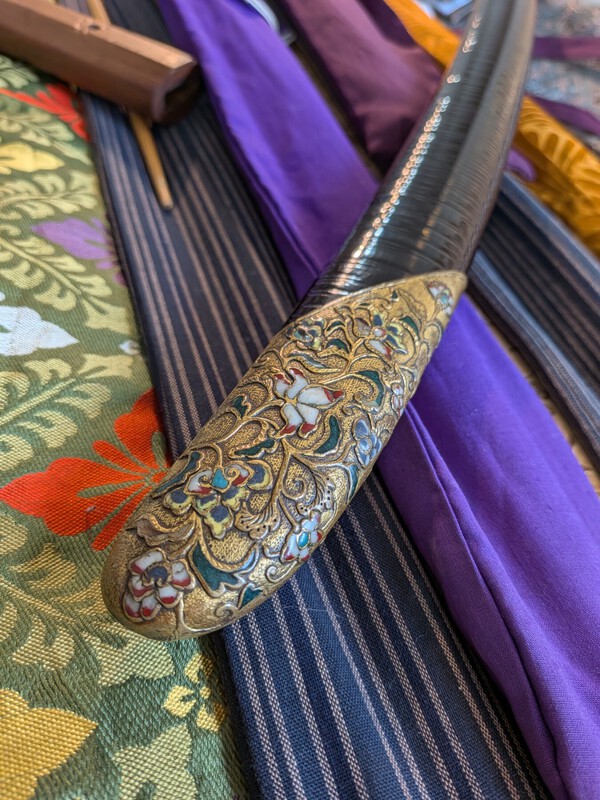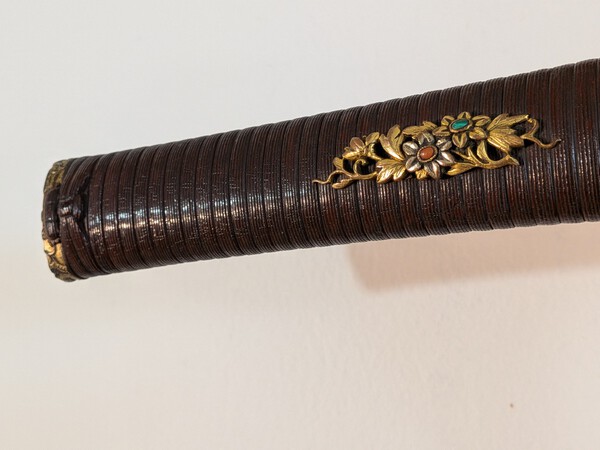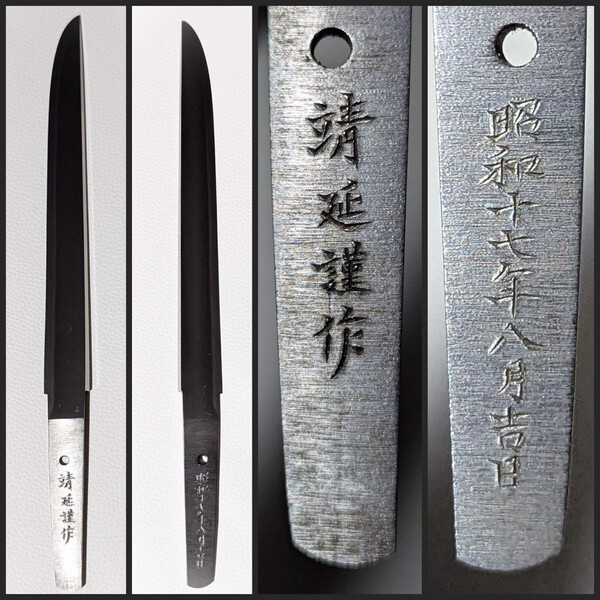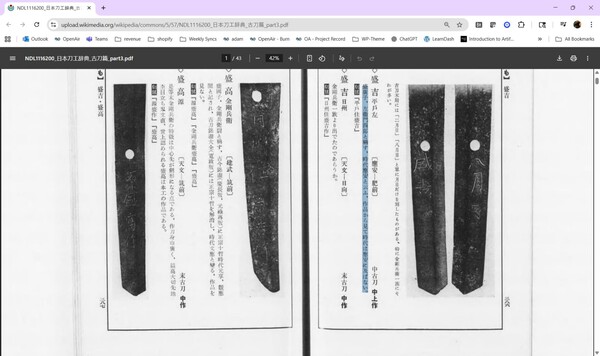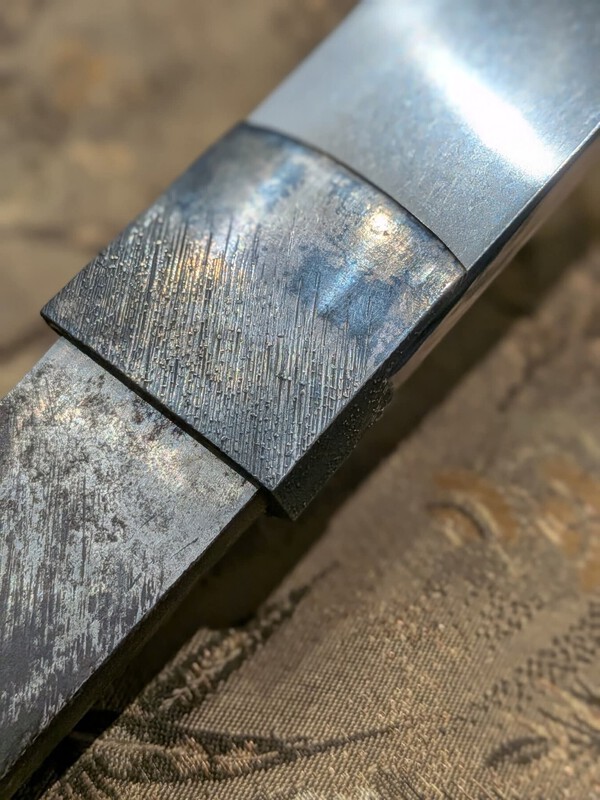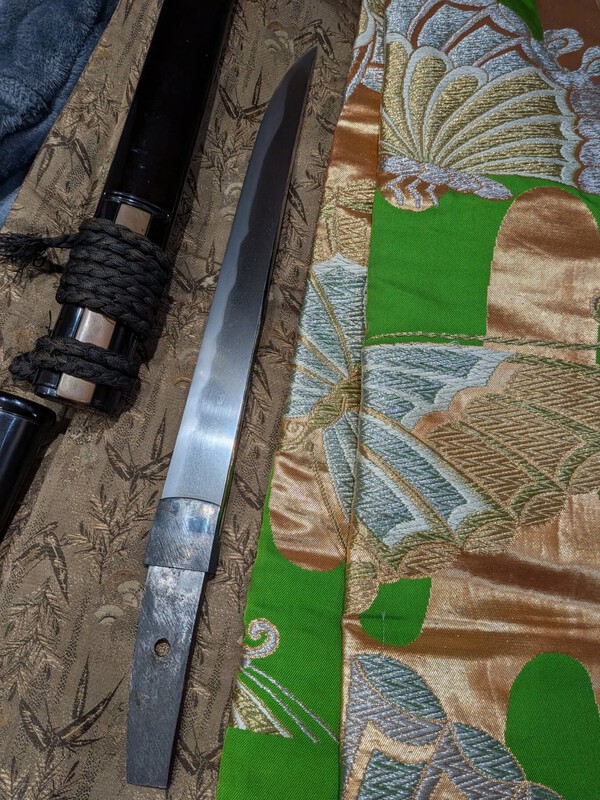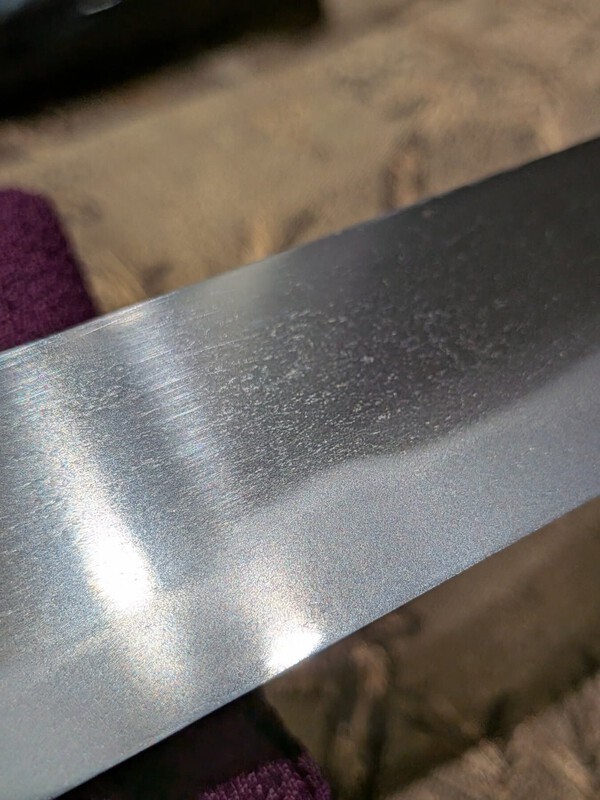-
Posts
5,209 -
Joined
-
Last visited
-
Days Won
140
Content Type
Profiles
Forums
Events
Store
Downloads
Gallery
Everything posted by Ray Singer
-
Any chance of seeing a clearer image? Perhaps Kanehide.
-
We will need to see the mei to answer. This is a date: October, 1943.
-
This is a koshirae I just received a few days ago with a signed signed So-den Bizen blade from one of Enbun Kanemitsu's students. The koshirae has inlaid coral and malachite (in addition to the cloissone elements). The fittings have an Ezo / Umetada look to them (excluding the kojiri). Best regards, Ray
- 26 replies
-
- 12
-

-

-

-
Perhaps the name itself at the bottom is a form of Sairen (西蓮)?
-
Yasuoki, a lucky day in February 1942 Yasuoki was one of the famous Yasukuni Shrine smiths who worked during the war era. https://www.google.com/search?q=Yasukuni+yasuoki+site%3Awww.militaria.co.za&client=ms-android-google&sca_esv=6b419d715691fe69&sxsrf=AE3TifNOdIuXVStnsrNxL8ac8AzXgKUeSQ%3A1757947355680&ei=2yXIaNueKfLJwt0Ph6eD4AU&oq=Yasukuni+yasuoki+site%3Awww.militaria.co.za&gs_lp=EhNtb2JpbGUtZ3dzLXdpei1zZXJwIilZYXN1a3VuaSB5YXN1b2tpIHNpdGU6d3d3Lm1pbGl0YXJpYS5jby56YUjcLVCFB1jWLXADeAGQAQCYAfsBoAHBD6oBBTAuNi40uAEDyAEA-AEBmAIKoALJDMICChAAGLADGNYEGEfCAgcQIRigARgKwgIFECEYqwLCAggQABiABBiiBJgDAIgGAZAGCJIHBTIuNS4zoAfqLLIHBTAuNS4zuAe3DMIHBzAuMi42LjLIBzM&sclient=mobile-gws-wiz-serp#ip=1
-
Yasunobu kinsaku tanto dated a lucky day in August, 1943. A lovely Yamashiro-den utushi-mono with ko-itame jihada and suguha-based hamon in ko-nie. Bio below courtesy of Markus Sesko. Price: $4,500 + shipping YASUNOBU (靖延), Shōwa (昭和, 1926-1989), Yamagata – “Murakami Yasunobu kinsaku” (村上靖延謹作), “Yasunobu” (靖延), real name Murakami Ensaku (村上円策), student of Ikeda Yasumitsu (池田靖光), he made about1,000 blades for the Yasukuni forge. Murakami YASUNOBU 村上靖延, given name Ensaku 円策 was born in April 24th, Meiji 40th (1907) in Yamagata prefecture. He joined The Nihonto Tanren Kai foundation (NTK) 日本刀鍛練会 in December 15th, Showa 8 (1933) with his chief master smith Ikeda YASUMITSU 池田靖光. After 5 years' practicee, he was given the official smith name YASUNOBU 靖延 by the War Minister, Itagaki Seishiro 板垣征四郎 in January 11th, Showa14 (1939) and played the chief role till the dissolution of NTK Showa 20th (1945) in the end of the War. Chairman awarded in the 2nd official military sword exhibition in December 21th, Showa19 (1944). Article below from to-ken.uk: "It was customary that swords were sometimes given as gifts by the emperor to graduates who attained distinguished grades at the Imperial Army Staff College and the Imperial Naval College. Known as “Onkashi-to”, katana were given to the Army whilst the Navy had tanto or daggers. These were swords of superior quality and the weight and dimensions, including the curvature, were very specific. After the inspection agreed that they were worthy of being Onkashi-to the smith was allowed to sign the sword and added the characters KINSAKU after his name, meaning “Respectfully made this”. Unlike normal work, the name inscription seems to have been made below the mekugi-ana or tang hole, on these swords. Of course as an Army organisation, it was unusual that even tanto blades would be made for the Navy, but this was because the official smith of the Imperial Naval College, Horii Toshihide, had become very ill and was unable to forge blades. Of course, it was a great honour for a swordsmith to have his work recognised as Onkashi-to. " https://to-ken.uk/onewebmedia/YASUKUNI.pdf
- 1 reply
-
- 5
-

-

-
Please show a photo of the full nakago. This is the typical nakago shape seen in Muromachi period Kongobyoe (on the right in the image below).
-
To my eyes, this looks like: Moritsugu. Look into Kongobyoe school.
-
Seki ju Kawamura Kanechika saku
-
I don't know which Yasuhiro this might be. There were several individuals. The nakago is suriage, and that affects the appearance as well, compared with reference examples. https://nihontoclub.com/view/smiths/meisearch?type=All&mei_op=contains&mei=康廣
-
Yasuhiro.
-
This is a high-quality, healthy and flawless Muromachi period tanto in very reserved and tasteful aikuchi tanto koshirae. The blade is done in gunome-midare in nie-deki, with a bright yakiba and deep ashi. The jihada is itame with a few flowing spots, ji-nie, chikei and is beautiful forged with no flaws. The blade is in very good and intact polish and resides with the koshirae. The aikuchi saya and tsuka are done in kuronuri (black lacquer) with a copper kozuka and black sageo. The blade has old NBTHK papers to kodai Kanefusa. $2,500 + shipping.
-

WWii Japanese samurai sword identification
Ray Singer replied to Mrbacon's topic in Military Swords of Japan
Noshu ju Fujiwara Masatsune. Appears to be a WWII showato arsenal blade. Best regards, Ray -
Signed Rai Kunimitsu, but unfortunately does not appear to be an authentic example of his inscription. The blade itself appears to be koto, however it looks to have been cleaned or wiped down with something abrasive and very little of the workmanship can be seen. How long is the blade, is it not tanto rather than wakizashi length?
-

Translation would be assistance greatly appreciated
Ray Singer replied to dwmc's topic in Translation Assistance
Please see below for other examples of Mantetsu-to mei. https://www.japaneseswordindex.com/koa.htm -
Soshu ju Hiromitsu This is not an authentic example by the famous early Soshu smith who used that mei.
-
Appears to be a showato arsenal blade by Fukumoto Kanemune. WWII era blade, not fully traditionally made.
-

translation In need of translation if possible
Ray Singer replied to buchtas's topic in Translation Assistance
Examples below. https://www.google.com/search?sca_esv=85427b9423f451d4&rlz=1C1ONGR_enUS1136US1136&sxsrf=AE3TifNl6HyAhyPtSRMRy6sEIuzysY2-9w:1756742766322&udm=2&fbs=AIIjpHxU7SXXniUZfeShr2fp4giZ1Y6MJ25_tmWITc7uy4KIeuYzzFkfneXafNx6OMdA4MRo3L_oOc-1oJ7O1RV73dx3MIyCigtuiU2aDjExIvydX85cOq96-7Mxd4KSNCLhHwZjNl1D--59A3Pz1jRAtenzCJ-qzCnOKtvU69k0YYAuhlzxHSrRNQ-gtEYBj8xSow3FJ3v7l7zsi4eO0Nw9mEGcGVLxNQ&q=近江守高木住助直&sa=X&ved=2ahUKEwiHqbHk-LePAxWBSDABHaKYAO8QtKgLegQIFRAB&biw=1536&bih=791&dpr=1.25 -

translation In need of translation if possible
Ray Singer replied to buchtas's topic in Translation Assistance
Hi Martin, the would indicate that it is by or purports to be by the famous Shinto Settsu smith Omi (no) kami Sukenao: 近江守高木 (住助直) Omi (no) kami Takagi (missing portion: ju Sukenao) It is dated Enpo 6 (the year 1678). https://nihontoclub.com/smiths/SUK358 -

Looking for help with a worn sayagaki.
Ray Singer replied to Coldramen's topic in Translation Assistance
There is a partial MUNE at the top. If the blade is signed Kunimune, then very likely that is what the sagagaki led with. The bottom appears to be a partially nagasa, which is information that you would have based on the current length. The middle section is unclear to my eyes.






